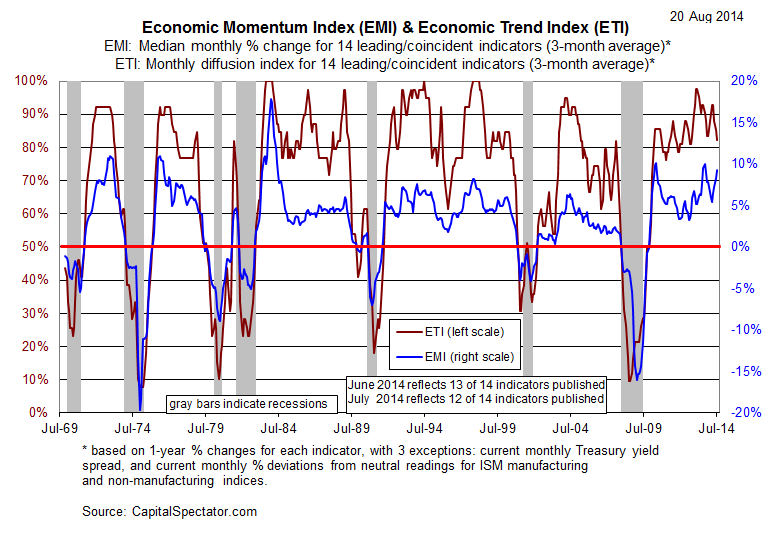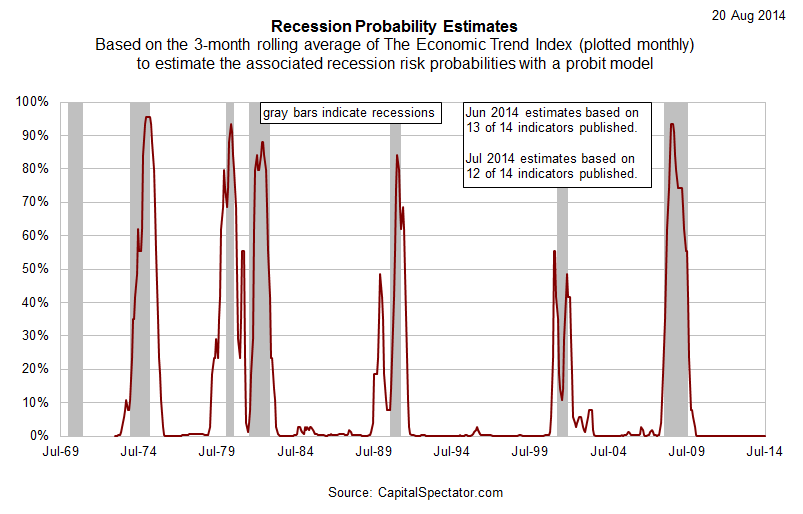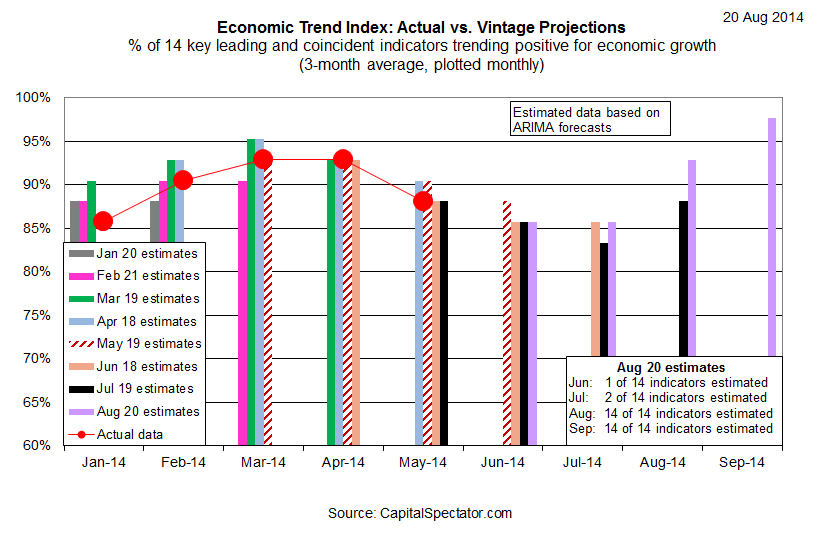Looking for recessions is an obsession for some folks. Every wobbly update, every release of bad news is a new excuse to see trouble around the next bend. But crying 'fire' in the theater of business-cycle analysis has been a fruitless pursuit for several years and there’s no sign in the current lineup of data that suggests the near-term future will be any different. The macro profile for the US continues to trend positive in the July update of a diversified set of 14 economic and financial indicators. In fact, the near-term projections for the overall trend reflect a stronger run of data for the months ahead.
Using a methodology outlined in Nowcasting The Business Cycle: A Practical Guide For Spotting Business Cycle Peaks, a broad review of economic and financial trends advises that recession risk remains low. The Economic Trend and Momentum indices (ETI and EMI, respectively) remain at levels that equate with expansion.
For a closer look at the numbers, let’s begin with a summary of the individual components for ETI and EMI. The one worrisome trend at the moment: the weak comparisons in the year-over-year changes for consumer sentiment. But this looks like noise in the grand scheme of US macro because the rest of the indicators look upbeat. It’s also true that the consumer sentiment index has forged a slow but steady path higher in recent years and so the recent run of flat-to-slightly lower levels vs. a year ago isn’t particularly troublesome at this stage. In any case, there’s always some corner of weakness in the economy, but that’s normal–even in a period of expansion.

Meanwhile, a big-picture review of all the data continues to look encouraging. Reviewing the historical record for ETI and EMI shows that both business cycle benchmarks are well above their respective danger zones: 50% for ETI and 0% for EMI. When the indexes fall below those tipping points, we’ll have clear warning signs that recession risk is elevated. For now, however, there’s still a sizable margin of safety between current values for July (82.2% for ETI and 9.3% for EMI) and the danger zones.

Translating ETI’s historical values into recession-risk probabilities via a probit model also suggests that business cycle risk remains low. To be precise, the data implies that the odds are virtually nil that the National Bureau of Economic Research (NBER)–the official arbiter of business cycle dates—will declare last month as the start of a new recession.

Next, let’s consider how ETI’s values may evolve as new data is published in the near future. One way to estimate expected values for this index is with an econometric technique known as an autoregressive integrated moving average (ARIMA) model, based on calculations via the “forecast” package for R, a statistical software environment. The ARIMA model calculates the missing data points for each indicator, for each month through September 2014. (May 2014 is currently the latest month with a complete set of published data). Based on today’s projections, ETI is expected to remain well above its danger zone in the near term.

Forecasts are always suspect, of course, but recent projections of ETI for the near-term future term have proven to be relatively reliable guesstimates vs. the full set of monthly reported numbers that followed. That’s not surprising, given the broadly diversified nature of ETI. Predicting individual components, by contrast, is prone to far more uncertainty in the short run. As such, the latest projections (the four purple bars on the right in the chart above) offer support for cautious optimism. The chart above also includes the vintage ETI projections published on these pages in previous months, which you can compare with the complete monthly sets of actual data that followed, based on current numbers (red circles). The assumption here is that while any one forecast for a given indicator is likely to be wrong, the errors may cancel one another out to some degree by aggregating a broad set of predictions into ETI. The historical record for this forecast methodology suggests that’s a reasonable assumption for peeking into the near-term future.
For additional perspective on judging the value of the forecasts based on the historical record, here are the previous updates for the last three months:
